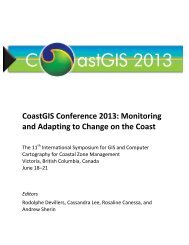in Context the SCotian Shelf - COINAtlantic
in Context the SCotian Shelf - COINAtlantic
in Context the SCotian Shelf - COINAtlantic
You also want an ePaper? Increase the reach of your titles
YUMPU automatically turns print PDFs into web optimized ePapers that Google loves.
plankton are dist<strong>in</strong>ctive among ocean biota <strong>in</strong> that<br />
<strong>the</strong>y derive <strong>the</strong>ir energy and structural materials<br />
directly from <strong>the</strong> environment. They require light<br />
and nutrients (e.g. nitrate, phosphate, silicate) for<br />
<strong>the</strong>ir growth. On <strong>the</strong> Scotian <strong>Shelf</strong>, diatoms and<br />
d<strong>in</strong>oflagellates are <strong>the</strong> largest and most common<br />
phytoplankton (Breeze et al. 2002). Their abundance<br />
is determ<strong>in</strong>ed by <strong>the</strong> <strong>Shelf</strong>’s complex physical<br />
oceanographic features. There is a dist<strong>in</strong>ctive<br />
seasonal cycle of growth characterized by a widespread<br />
spr<strong>in</strong>g spr<strong>in</strong>g “bloom” and a more diffuse<br />
fall bloom. Blooms are a high concentration of<br />
phytoplankton <strong>in</strong> an area caused by <strong>in</strong>creased reproduction<br />
and result<strong>in</strong>g <strong>in</strong> a discoloration of <strong>the</strong><br />
water (Garrison 2005). Blooms vary <strong>in</strong> duration<br />
and scale. Trends <strong>in</strong> <strong>the</strong> magnitude and duration<br />
of <strong>the</strong> spr<strong>in</strong>g bloom on <strong>the</strong> Scotian <strong>Shelf</strong> <strong>in</strong>dicate<br />
that blooms beg<strong>in</strong> earlier now than <strong>the</strong>y did <strong>in</strong><br />
<strong>the</strong> 1960s and 1970s and are more <strong>in</strong>tense and<br />
longer (Zwanenburg et al. 2006).<br />
Zooplankton are divided <strong>in</strong>to three ma<strong>in</strong> categories<br />
on <strong>the</strong> basis of size: microzooplankton, mesozooplankton,<br />
and macrozooplankton. Zooplankton<br />
are important food sources for higher trophic<br />
levels, <strong>in</strong>clud<strong>in</strong>g juvenile groundfish, pelagic fish<br />
species and baleen whales (Zwanenburg et al.<br />
2006). The mesozooplankton on <strong>the</strong> Scotian<br />
<strong>Shelf</strong> is dom<strong>in</strong>ated by copepods. Three species<br />
of copepods, known as Calanus, make up > 70%<br />
of <strong>the</strong> copepod biomass. Calanus f<strong>in</strong>marchicus<br />
appears to be a significant l<strong>in</strong>k <strong>in</strong> <strong>the</strong> food cha<strong>in</strong><br />
(Zwanenburg et al. 2006) On <strong>the</strong> Scotian <strong>Shelf</strong>,<br />
zooplankton levels have been lower <strong>in</strong> more<br />
recent years than <strong>in</strong> <strong>the</strong> 1960s/70s (<strong>the</strong> reverse<br />
of <strong>the</strong> phytoplankton trend) and are beg<strong>in</strong>n<strong>in</strong>g<br />
to recover from <strong>the</strong> lows observed <strong>in</strong> <strong>the</strong> 1990s<br />
(Harrison et al. 2007).<br />
Plankton research and monitor<strong>in</strong>g has been occurr<strong>in</strong>g<br />
on <strong>the</strong> Scotian <strong>Shelf</strong> for decades. A more<br />
description of research related to plankton is<br />
provided <strong>in</strong> Breeze et al. 2002.<br />
Mar<strong>in</strong>e Plants<br />
Mar<strong>in</strong>e plants are macrophytic mar<strong>in</strong>e algae<br />
commonly referred to as seaweeds. The Natural<br />
History of Nova Scotia produced by <strong>the</strong> Nova<br />
Scotia Museum of Natural History provides a<br />
general overview of mar<strong>in</strong>e plants <strong>in</strong> Nova Scotia.<br />
Seaweeds along <strong>the</strong> rocky shores of Nova Scotia<br />
can be grouped <strong>in</strong>to <strong>the</strong> follow<strong>in</strong>g categories:<br />
green algae, red algae and brown algae. Green<br />
algae need a large amount of light and are generally<br />
found closer to <strong>the</strong> surface <strong>in</strong> <strong>in</strong>tertidal or<br />
shallow subtidal areas. Nova Scotia has 82 known<br />
species of green algae. Red algae are able to<br />
grow at greater depths and are generally found<br />
<strong>in</strong> <strong>the</strong> <strong>in</strong>tertidal zone, below <strong>the</strong> low water mark.<br />
Common red algae <strong>in</strong> Nova Scotia <strong>in</strong>clude irish<br />
moss. Brown algae are <strong>the</strong> dom<strong>in</strong>ant seaweeds<br />
and are exclusively mar<strong>in</strong>e. Kelp is <strong>the</strong> largest<br />
of <strong>the</strong> brown algae and is found <strong>in</strong> <strong>the</strong> subtidal<br />
zone. Rockweeds are common <strong>in</strong> <strong>the</strong> <strong>in</strong>tertidal<br />
zone (Davis and Browne 1996).<br />
http://co<strong>in</strong>atlantic.ca/<strong>in</strong>dex.php/state-of-<strong>the</strong>-scotian-shelf<br />
17













